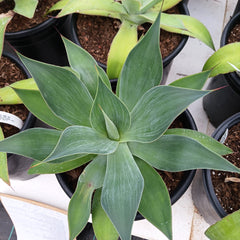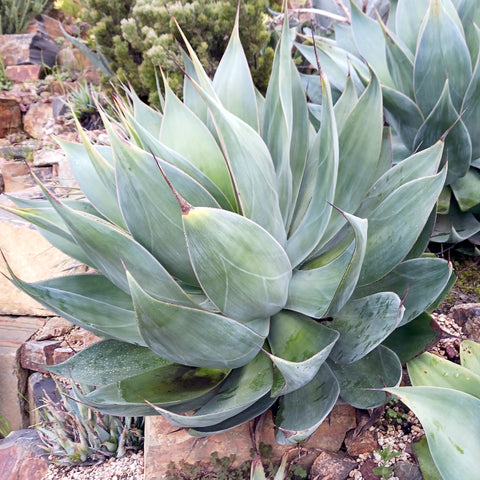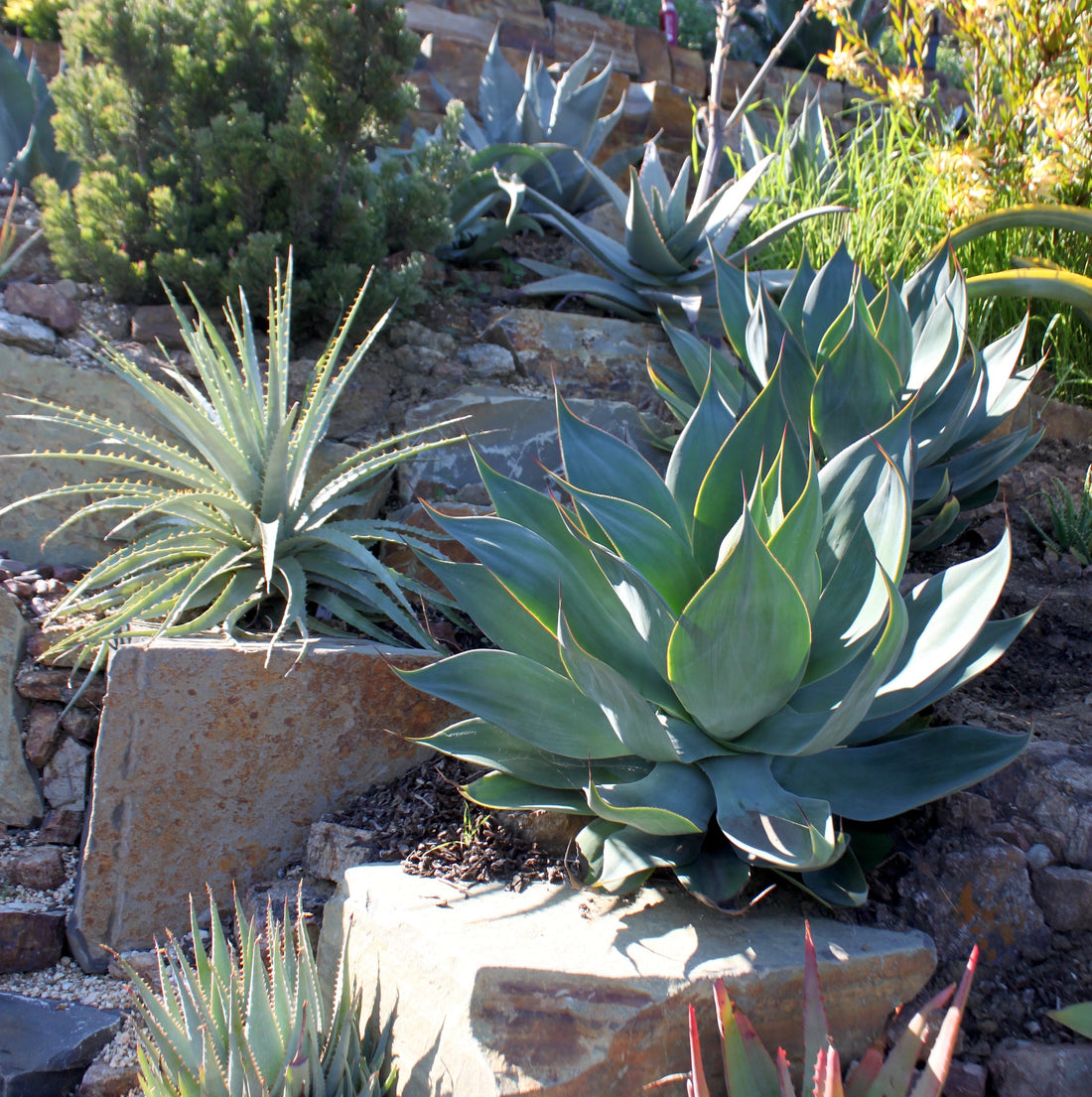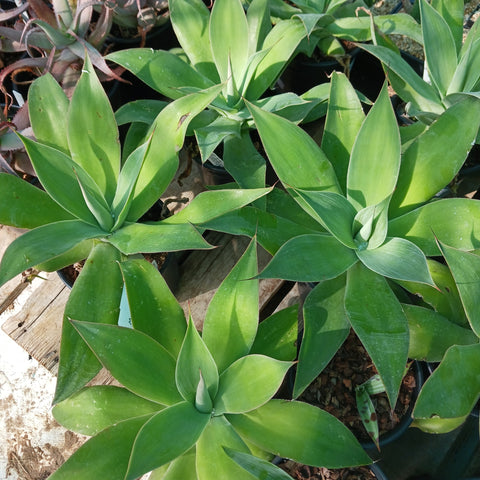Agave "Blue Flame" (Agave shawii x Agave attenuata) is a stunning succulent prized for its striking blue-green foliage with white waxy coating, reminiscent of flickering flames. Its low-maintenance nature and architectural beauty make it a popular choice for waterwise gardening enthusiasts.
Growing Conditions:
Light
Blue Flame Agave thrives in full sun but can tolerate partial shade, especially in hot climates. Ensure it receives at least six hours of direct sunlight daily for optimal growth and vibrant leaf coloration.

Soil
Well-drained, sandy loam soil is ideal for Blue Flame Agave. Although not absolutely needed, you can amend soil with perlite or pumice to improve soil drainage. The key is to avoid water-logging, as it can lead to root rot. Planting on a hill or berm will help avoid water-logging of roots as well.
Temperature and Humidity
Blue Flame Agave prefers temperatures between 55°F to 75°F and humidity levels between 40% to 60%. While it's hardy down to 25°F, protect it from prolonged exposure to freezing temperatures. Our plants have done well in temperatures that regularly reach the lower 30°'s in the Winter to in excess of 100°F during the Summer.

Watering and Maintenance
Water
During it's first year in the landscape, water "Blue Flame" Agave infrequently, but deeply, allowing the soil to dry out between waterings. Over-watering can lead to root rot, so err on the side of under-watering. Once the plant is established there is no need to water in all but the driest of regions. Established Agave "Blue Flame" can survive and thrive on seasonal rain water.
Signs of over-watering include:
- Yellowing or browning of the leaves, starting from the bottom of the plant.
- Soft, mushy, or translucent leaves.
- Root rot, indicated by a foul odor emanating from the soil or mushy, blackened roots.
- Wilting or drooping leaves, despite the soil being moist.
- Presence of fungus gnats or other pests attracted to overly damp soil.

Maintenance
Pruning or maintaining Agave "Blue Flame" is relatively straightforward, as this plant typically requires minimal upkeep. Here are some tips for keeping your Agave "Blue Flame" healthy and looking its best:
1. Remove Dead or Damaged Leaves: Periodically inspect your Agave "Blue Flame" for any dead, damaged, or yellowing leaves. Use clean, sharp pruning shears to carefully trim away these undesirable parts. Removing dead or damaged leaves not only improves the plant's appearance but also prevents potential pest and disease issues.
2. Trim Flower Stalks: Agave "Blue Flame" produces tall flower stalks, especially as it reaches maturity. While the flowers can be visually appealing, they can also divert energy away from the plant's growth. If you prefer to maintain the plant's compact form or prevent it from flowering, you can trim the flower stalks as soon as they emerge using pruning shears.
3. Clean Base: Clear away any debris or dead leaves that accumulate around the base of the plant. This helps improve air circulation and reduces the risk of pests or diseases.
Fertilization
Blue Flame Agave is a slow-growing plant and doesn't require fertilization. However, you can apply a slow-release fertilizer in spring or use compost as a natural alternative. if applying fertilizer look for balanced fertilizer formulated specifically for succulents or cacti. A fertilizer with an N-P-K ratio (nitrogen-phosphorus-potassium) of around 10-10-10 or similar proportions is ideal.

Size, Growth, and Lifespan
Blue Flame Agave typically grows to heights of 2-3 feet with a width of 3-4 feet. As it matures, it forms clumps or dense masses, reaching up to 8-10 feet wide and 4-5 feet tall. Agave "Blue Flame" typically takes around 5 to 10 years to reach maturity. It has a long lifespan but is monocarpic, meaning it blooms once before dying.
Pests, Diseases, and Indoor Care
Pests
Common pests include snails, slugs, Agave snout weevils, and scale insects. Control pests by applying appropriate repellents or treatments. Indoors, ensure adequate air circulation to prevent pest infestations.
Diseases
Blue Flame Agave is susceptible to leaf spot and gray mold. Remove affected leaves promptly to prevent the spread of disease. Ensure good air circulation and avoid overhead watering to reduce humidity levels and minimize disease risk.
More about Prevention:
- Regularly inspect your Agave "Blue Flame" for signs of pest infestation or disease.
- Practice good sanitation by removing dead or damaged leaves and debris from around the plant.
- Avoid overwatering and ensure proper soil drainage to prevent root rot.
- Use insecticidal soaps, horticultural oils, or natural predators to control pest infestations.
- If necessary, treat fungal diseases with fungicides labeled for use on succulent plants, following the manufacturer's instructions carefully.
Indoor Care
Agave "Blue Flame" when grown indoors should be placed near a sunny window where it can receive ample sunlight. Ensure pots have proper drainage to prevent water-logging. Rotate the plant periodically to ensure even growth.
Conclusion
Agave "Blue Flame" is a stunning, hardy succulent that adds a touch of elegance to waterwise gardens.They are easy to care for once established and look great in the garden singly or planted en masse.

